During the Early Modern era, African American's had a massive influence on the art of the era. This is due mainly to the Harlem Renaissance, which lasted from the 1910's to the 1930's. It grew within Harlem New York, and was considered a Renaissance of African American art, music, and overall culture.
Due to rapid improvements in this area, buildings weren't filled, and landlords wanted to fill the vacancy's. The middle class black community began to move in, and the area became flooded, due to a "Great Migration" from the south.
Art from this time was often inspired by the artist's African roots, and called back to a time before African's were transported to the USA against their will. It acted as a glue for African American's, bringing them together as one concise cultural push in the arts, something they had been frequently barred from participating in. The Harlem Renaissance, in my perception, is the refusal of white culture, and instead was the creation of something unique and innately African American.
This photograph is called
Figure of a Young Woman, Pahouin, Border of Spanish Guinea, by Walker Evans in 1935. This was photographed at New York's Museum of Modern Art, and I could not find the original sculptor. This creator produced a 477 print collection of "African Nego Art,"
prints mostly given to African American educational institutions.
The first aspect of this piece I find to be interesting is the pieces form. It seems disproportionate, when compared to the traditional American standard of the human body. To mention a few discrepancies, waist down appears too short, the shoulders protrude beyond the arms, and the head is too large for the body it's attached to. This lends it some interest for me, because it draws attention to various quadrants of the figure. I think when working with sculpture, you have many opportunities to manipulate proportions, because it draws the eye in with ease.
The second element I noticed is the artist's use of line. There are no harsh edges or sudden stops. If one was to start from the top of the head, they could trace the entirety of the sculpture. As someone who has troubles knowing what to focus on in artwork, the way this sculpture leads the eye is very pleasing to look at.
Finally, this photograph picks up an amazing texture to the metal. It seems rough in certain places, despite its reflective quality. Although it's likely just a trick of the light, it gives the feeling of skin and aliveness to the sculpture. This is especially noticeable just above the knees, and around the bellybutton.
This piece seems small. I know sculpture can vary pretty wildly, but whenever I've seen these African inspired pieces, they're generally the size of a mug or smaller. Because of it's size, and my appreciation for the novel representation of the human form, I think it would be a nice addition to my art collection.
The first element of this piece that I adore is the use of color. By using yellow and purple and green, the piece has a lot of contrast. Additionally, each color is decently bright, which adds liveliness to an otherwise one-dimensional piece.
Secondly, the artist uses space, in order to represent a grand scale. Above the heads of the men on the bottom, there is emptiness, except for who I assume to be Gabriel blowing his horn. This makes Gabriel seem massive, and beyond that, Godly. He towers above others, and looms above them, standing as tall as the sky.
Finally, the artist uses shape in order to portray the events of the painting. His painting's busy nature comes from the use of color, not an influx of detail. People are simple shapes, and nothing draws particular attention.
I really love this painting. I think the one-dimensional nature is an interesting step back from the overly detailed pieces we've been viewing in this class. The color is abstract, the shapes are simple, and overall it contributes an immense amount of serotonin to my being. Assuming it's not too large, this piece would be such a nice addition to any place I lived.
This piece holds an obvious emphasis on African-American's, and their influence on the art of the time. It represents the generational trauma of slavery, embodied in his grandma's weary hands, worn face, and flat expression. Even her shadow appears to be withering. Additionally, his art marks a historic moment for the African American community, due to his attendance at a prestigious art academy.
The first element here that stands out is the artist's use of tone. Especially when looking at the skin, some sections are lighter, giving the appearance of age or liver spots dotting the skin. It adds to the worn and rugged look of the subject. The tone alterations in her shirt are also very interesting, because it gives the illusion of transparency. I think this stuck out because shirts that intentionally appear this way are a rather recent fashion trend, so it makes her seem poor, because her clothes appear worn and see-through.
Secondly, the artist's use of color is very nice. The painting sticks to entirely neutrals, which is a bold choice, especially considering the vibrancy I saw in other art from this period. It mutes the mood, and makes the subject seem very calm. Whenever I see a piece with this fully neutral pallet, it makes me calm, and reminds me of the earth.
Finally, the artist's use of space caught my attention. I love the emptiness behind the grandma. It makes her seem lonely, and, forces the viewer to confront the possibly uncomfortable result of a lifetime of slavery. I've found as class progresses that I really am a fan of these empty backgrounds, because it makes the subject matter much more apparent and appreciated.
I am not a big fan of realistic art. It makes me kind of uncomfortable, and I find I avoid looking at it when it's very focused and doesn't have a busy background. Because of that, I probably wouldn't own it, but I think I would greatly appreciate it if I came across it in a gallery or other exhibition.
Citations
“Aaron Douglas.” Biography.com, A&E Networks Television, 28 July 2020, www.biography.com/artist/aaron-douglas.
“Archibald Motley.” Wikipedia, Wikimedia Foundation, 26 Oct. 2020, en.wikipedia.org/wiki/Archibald_Motley.
“God's Trombones.” Wikipedia, Wikimedia Foundation, 11 June 2019, en.wikipedia.org/wiki/God's_Trombones.
History.com Editors. “Harlem Renaissance.” History.com, A&E Television Networks, 29 Oct. 2009, www.history.com/topics/roaring-twenties/harlem-renaissance.
“National Gallery of Art.” Harlem Renaissance, www.nga.gov/education/teachers/lessons-activities/uncovering-america/harlem-renaissance.html.



Hi June!
ReplyDeleteI thoroughly enjoyed reading and looking through your exhibit on the Early Modern era. I wasn't very familiar with the Harlem Renaissance until we dove into this era and your blog post, so I really appreciate you covering a piece of history that isn't commonly discussed (for me). Your attention to detail is incredibly refreshing. For Figure of a Young Woman, Pahouin, Border of Spanish Guinea, you pointed out the rough patches throughout the metal sculpture and how they help bring this sculpture to life with the illusion of real, textured skin. In Portrait of my Grandma, you mentioned how the use of space and emptiness surrounding the woman draws emphasis on forcing the viewer to confront the "possibly uncomfortable result of a lifetime of slavery", and I thought that was absolutely necessary to bring into your assessment. Thank you for a great read!
I really appreciate that you included three completely different styles of art here. The first piece is so beautiful in how it represents the origin culture of African Americans—this totem(?) reminds me of Orisha representations from Yoruba. I love that the second painting really shows a feeling of rising up, triumph, and moving away from oppression to the idea of liberation (still a work in progress), but it gives a feeling of hope that really overflows from any other message. After having read how the third portrait kind of makes you feel uncomfortable, I went back up to it and took a closer look and it actually gave me a feeling of discomfort as well. There seems to be an underlying anxiety here that I would have missed if I hadn't read your commentary on the painting. I really do love how all of these paintings came together in support of a common theme of African Americans and their influence in Early 20th Century art, with representations of so many different styles.
ReplyDelete